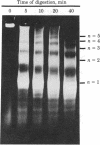Abstract
When animal cells replicate chromatin under conditions precluding new histone biosynthesis, half of the daughter DNAs are devoid of nucleosomes and are sensitive to staphylococcal nuclease. DNA sequences resistant to nuclease are associated with preexisting nucleosomes, which redistribute to progeny DNA duplexes during replication. We labeled newly replicated DNA sequences in a simian virus 40 (SV40)-transformed Chinese hamster cell clone with 5-bromodeoxyuridine (BrdUrd) in the presence and absence of a protein biosynthesis inhibitor, emetine. We resolved single-stranded BrdUrd- and dT-DNA sequences protected from nuclease digestion by nucleosomes and determined from which strands of the integrated viral DNA parental template (dT) and newly replicated progeny (BrdUrd) sequences were derived. Because we knew that the cell clone studied contained all of its integrated SV40 DNA at a single chromosomal site, we were able to determine that preexisting nucleosomes segregated to only one of the two daughter duplexes containing the integrated viral sequence. Additionally, in the presence of emetine, the integrated viral origin of replication, ORIsv, appeared not to function as a chromosomal replication origin, perhaps reflecting the drug's effect on synthesis of SV40 large tumor antigen.
Full text
PDF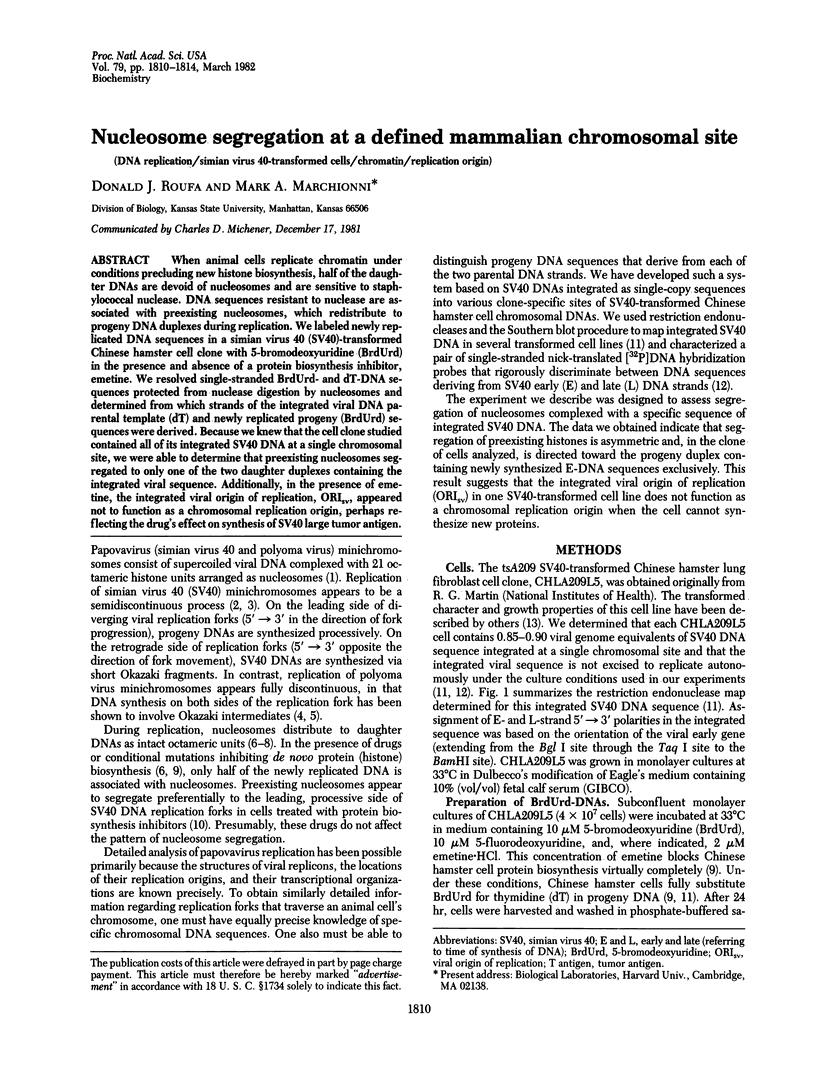
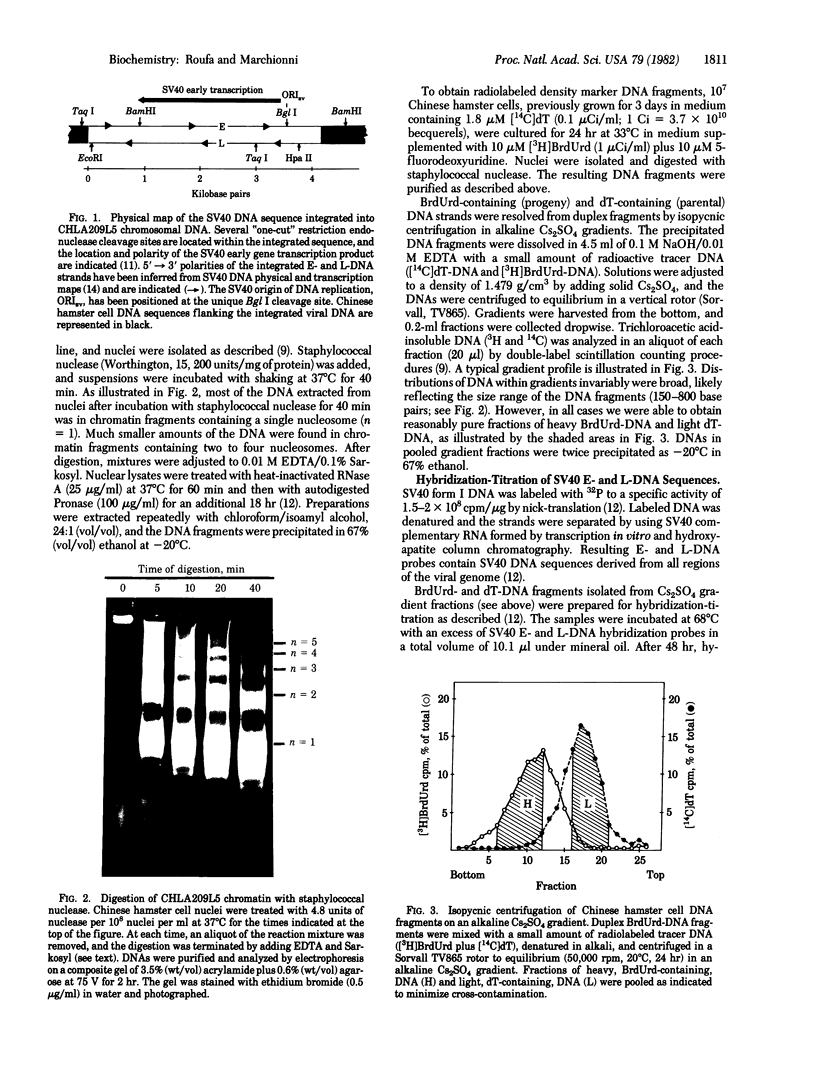
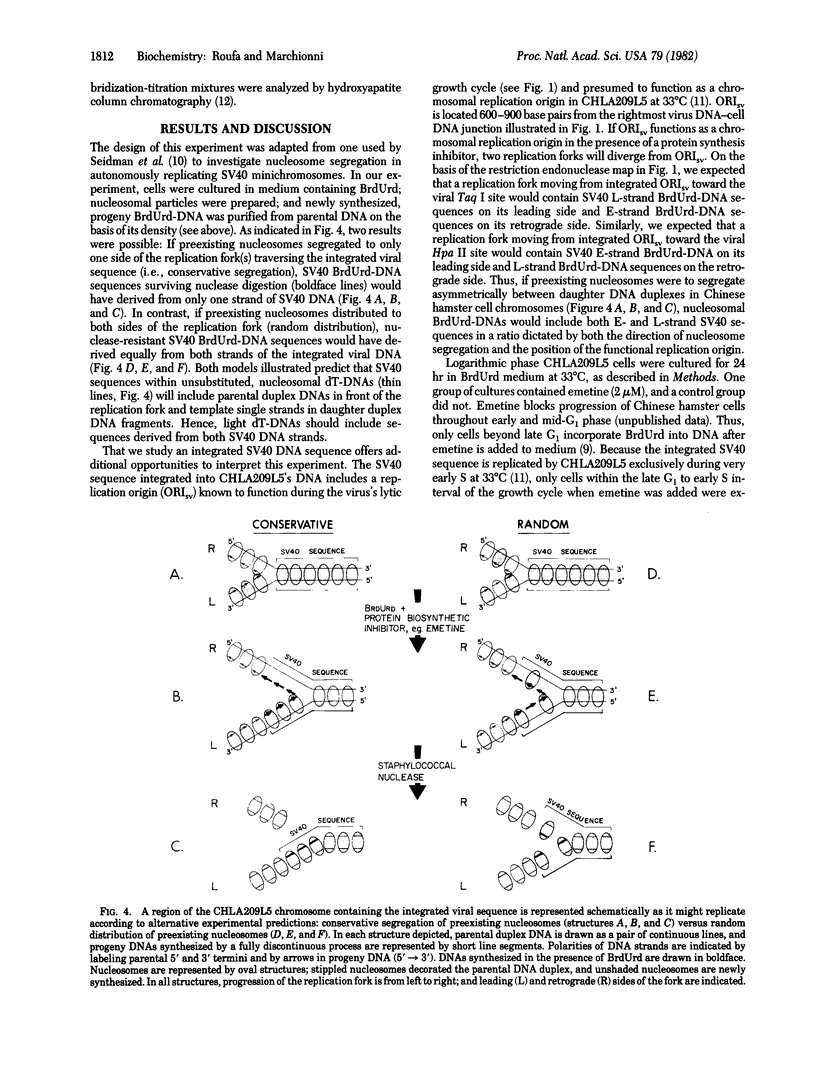
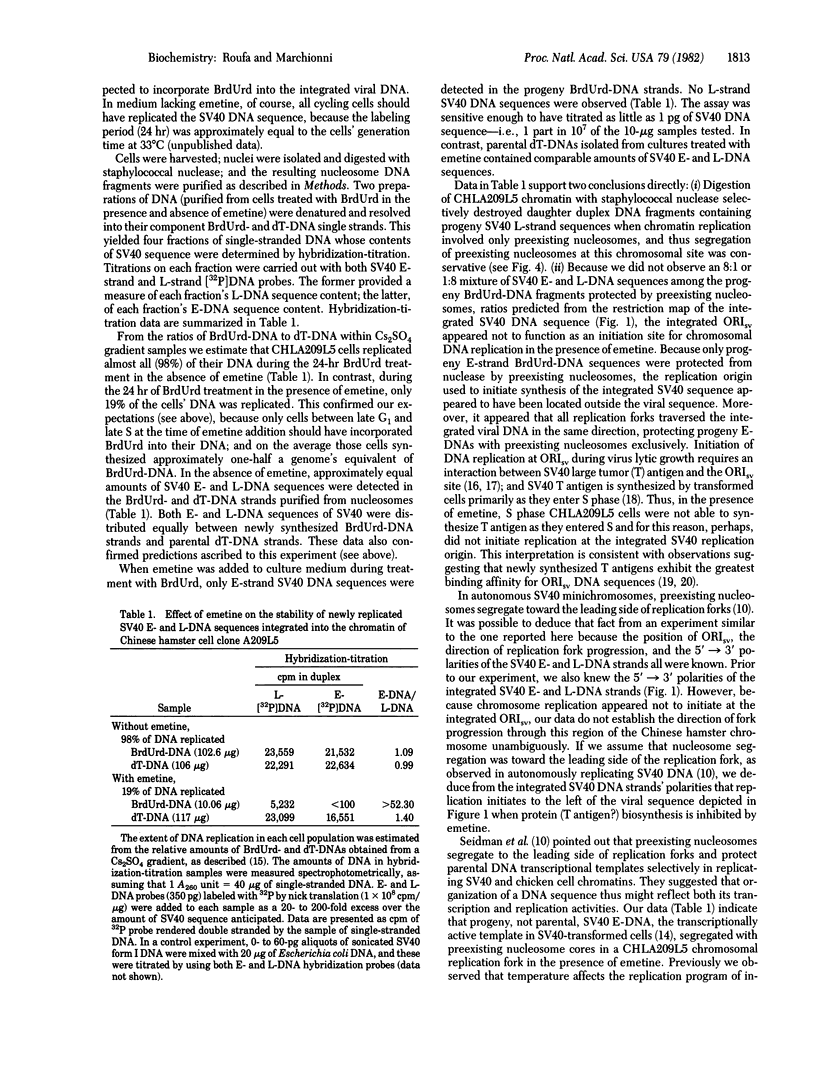
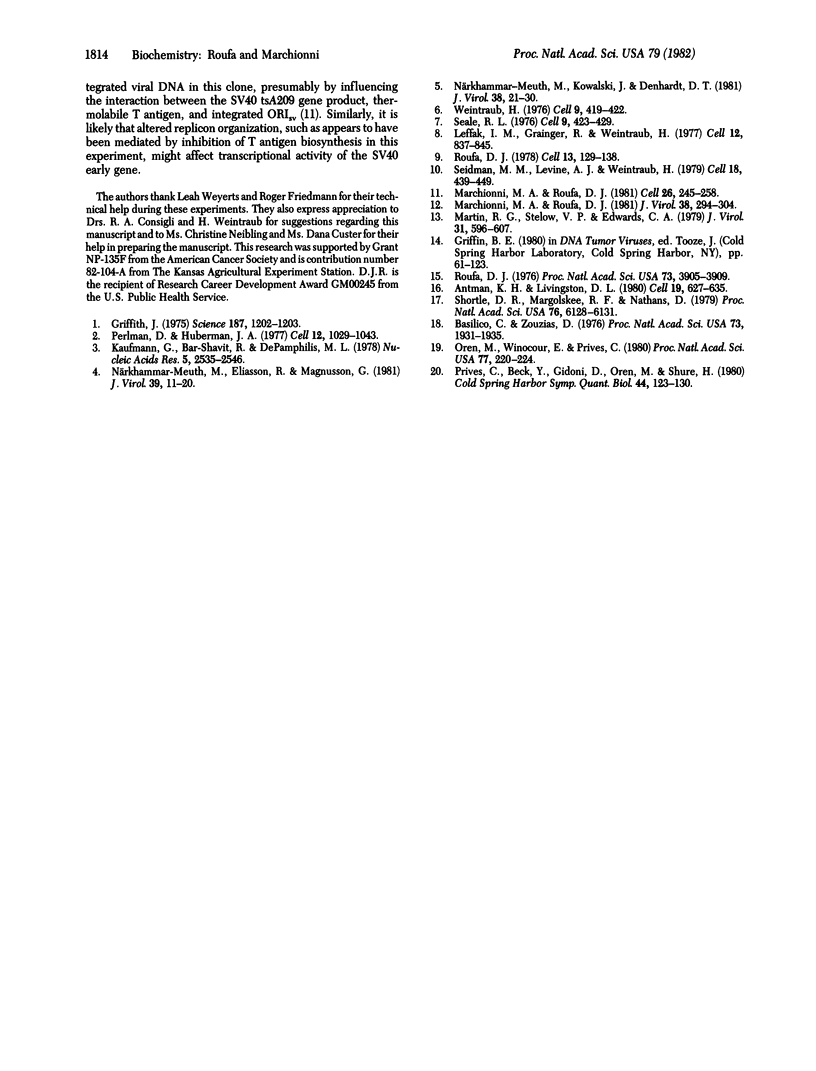
Images in this article
Selected References
These references are in PubMed. This may not be the complete list of references from this article.
- Antman K. H., Livingston D. M. Intracellular neutralization of SV40 tumor antigens following microinjection of specific antibody. Cell. 1980 Mar;19(3):627–635. doi: 10.1016/s0092-8674(80)80039-0. [DOI] [PubMed] [Google Scholar]
- Basilico C., Zouzias D. Regulation of viral transciption and tumor antigen expression in cells transformed by simian virus 40. Proc Natl Acad Sci U S A. 1976 Jun;73(6):1931–1935. doi: 10.1073/pnas.73.6.1931. [DOI] [PMC free article] [PubMed] [Google Scholar]
- Griffith J. D. Chromatin structure: deduced from a minichromosome. Science. 1975 Mar 28;187(4182):1202–1203. doi: 10.1126/science.187.4182.1202. [DOI] [PubMed] [Google Scholar]
- Kaufmann G., Bar-Shavit R., DePamphilis M. L. Okazaki pieces grow opposite to the replication fork direction during simian virus 40 DNA replication. Nucleic Acids Res. 1978 Jul;5(7):2535–2545. doi: 10.1093/nar/5.7.2535. [DOI] [PMC free article] [PubMed] [Google Scholar]
- Leffak I. M., Grainger R., Weintraub H. Conservative assembly and segregation of nucleosomal histones. Cell. 1977 Nov;12(3):837–845. doi: 10.1016/0092-8674(77)90282-3. [DOI] [PubMed] [Google Scholar]
- Marchionni M. A., Roufa D. J. Replication of viral DNA sequences integrated within the chromatin of SV40-transformed Chinese hamster lung cells. Cell. 1981 Oct;26(2 Pt 2):245–258. doi: 10.1016/0092-8674(81)90307-x. [DOI] [PubMed] [Google Scholar]
- Marchionni M. A., Roufa D. J. Titration of integrated simian virus 40 DNA sequences, using highly radioactive, single-stranded DNA probes. J Virol. 1981 Apr;38(1):294–304. doi: 10.1128/jvi.38.1.294-304.1981. [DOI] [PMC free article] [PubMed] [Google Scholar]
- Martin R. G., Setlow V. P., Edwards C. A. Roles of the simian virus 40 tumor antigens in transformation of Chinese hamster lung cells: studies with simian virus 40 double mutants. J Virol. 1979 Sep;31(3):596–607. doi: 10.1128/jvi.31.3.596-607.1979. [DOI] [PMC free article] [PubMed] [Google Scholar]
- Närkhammar-Meuth M., Eliasson R., Magnusson G. Discontinuous synthesis of both strands at the growing fork during polyoma DNA replication in vitro. J Virol. 1981 Jul;39(1):11–20. doi: 10.1128/jvi.39.1.11-20.1981. [DOI] [PMC free article] [PubMed] [Google Scholar]
- Närkhammar-Meuth M., Kowalski J., Denhardt D. T. Both strands of polyoma DNA are replicated discontinuously with ribonucleotide primers in vivo. J Virol. 1981 Jul;39(1):21–30. doi: 10.1128/jvi.39.1.21-30.1981. [DOI] [PMC free article] [PubMed] [Google Scholar]
- Oren M., Winocour E., Prives C. Differential affinities of simian virus 40 large tumor antigen for DNA. Proc Natl Acad Sci U S A. 1980 Jan;77(1):220–224. doi: 10.1073/pnas.77.1.220. [DOI] [PMC free article] [PubMed] [Google Scholar]
- Perlman D., Huberman J. A. Asymmetric Okazaki piece synthesis during replication of simian virus 40 DNA in vivo. Cell. 1977 Dec;12(4):1029–1043. doi: 10.1016/0092-8674(77)90167-2. [DOI] [PubMed] [Google Scholar]
- Prives C., Beck Y., Gidoni D., Oren M., Shure H. DNA binding and sedimentation properties of SV40 T antigens synthesized in vivo and in vitro. Cold Spring Harb Symp Quant Biol. 1980;44(Pt 1):123–130. doi: 10.1101/sqb.1980.044.01.014. [DOI] [PubMed] [Google Scholar]
- Roufa D. J. 5-bromodeoxyuridine-DNA strand symmetry and the repair of photolytic breaks in Chinese hamster cell chromosomes. Proc Natl Acad Sci U S A. 1976 Nov;73(11):3905–3909. doi: 10.1073/pnas.73.11.3905. [DOI] [PMC free article] [PubMed] [Google Scholar]
- Roufa D. J. Replication of a mammalian genome: the role of de novo protein biosynthesis during S phase. Cell. 1978 Jan;13(1):129–138. doi: 10.1016/0092-8674(78)90144-7. [DOI] [PubMed] [Google Scholar]
- Seale R. L. Studies on the mode of segregation of histone nu bodies during replication in HeLa cells. Cell. 1976 Nov;9(3):423–429. doi: 10.1016/0092-8674(76)90087-8. [DOI] [PubMed] [Google Scholar]
- Seidman M. M., Levine A. J., Weintraub H. The asymmetric segregation of parental nucleosomes during chrosome replication. Cell. 1979 Oct;18(2):439–449. doi: 10.1016/0092-8674(79)90063-1. [DOI] [PubMed] [Google Scholar]
- Shortle D. R., Margolskee R. F., Nathans D. Mutational analysis of the simian virus 40 replicon: pseudorevertants of mutants with a defective replication origin. Proc Natl Acad Sci U S A. 1979 Dec;76(12):6128–6131. doi: 10.1073/pnas.76.12.6128. [DOI] [PMC free article] [PubMed] [Google Scholar]
- Weintraub H. Cooperative alignment of nu bodies during chromosome replication in the presence of cycloheximide. Cell. 1976 Nov;9(3):419–422. doi: 10.1016/0092-8674(76)90086-6. [DOI] [PubMed] [Google Scholar]



